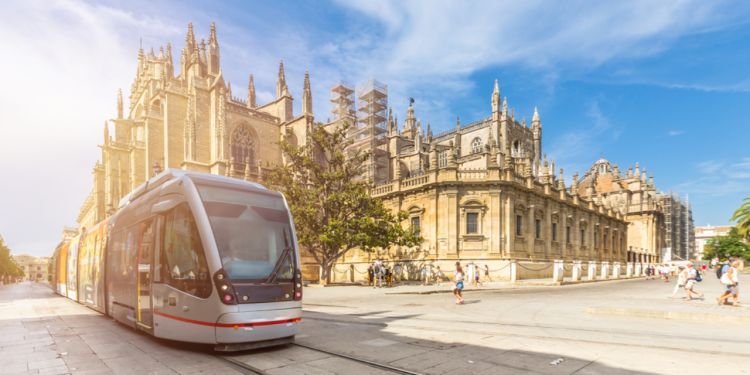
While the capital of Andalusia has a long and ancient history that stretches back to the eighth century BC, its public transport system is anything but old and creaking. With a city center tram service, metro, bicycle lanes, taxis and an extensive bus network that reaches suburbs and satellite towns, Seville is a very easy city to get around.
Commuting for work in Seville
The peak weekday congestion levels, when the city goes to work, are typically between 7:30 am and 9 am, between 2 pm and 3 pm and again between 6 pm and 8 pm. If you commute to and from work by car, expect to add 12 minutes to your travel time for every 30 minutes spent in your vehicle. During peak evening hours, you could spend an additional ten minutes in your car for every 30 minutes on the road.
Commuting by metro
A relatively hassle-free and less infuriating way to get to and from work is on the metro. The network serves the city and its metropolitan area and encompasses 21 stations spread across three zones on one line. More lines are being planned for the future.
Currently, metro single tickets cost 1.35 to 1.80 euros depending on the distance of your ride. Return journeys are from 2.70 to 3.60 euros. However, there are several ways you can ensure metro travel makes even less of a dent in your pocket. For example, with a one-day travelcard offering an unlimited number of journeys for 4.50 euros or the Bono Plus 45 travelcard. This allows 45 journeys of the same type (traveling in one, two or all three zones) during a maximum period of 30 days from the purchase date.
The cost of a Bono Plus 45 travelcard is: one zone costs 30 euros, two zones cost 42 euros, and three zones will set you back 50 euros.
Commuting by bus
Buses are a quick and efficient way to move around Seville. Their passage through congested peak-hour roads is made easier by miles of segregated bus lanes. Tickets cost 1.40 euros per one-way trip, but a cheaper option is to buy a rechargeable 30-day or student travel card. Details of prices, routes, and timetables are available on the official website of TUSSAM (Transportes Urbanos de Sevilla, SAM).
Commuting by tram
Seville's tram service has just one line, between Plaza Nueva and San Bernardo. It connects the city center's main attractions. There are five stations along its 2.2-kilometer (1.4-mile) length, including the terminals. Typical fare prices are 1.40 euros for a single journey.
Commuting by bike
Seville is a relatively flat city and very bike-friendly. There are approximately 180 kilometers of green-tarmacked bike lanes that are separated from vehicle traffic by raised kerbs and fencing.
Alongside this ever-expanding bike network is a public bike rental service with thousands of unisex bicycles available at more than 260 stations around the city. It costs 13.33 euros (plus insurance) to register with the system for a 7-day plan. The first 30 minutes are free, after which you pay 1.03 euros for the first hour and 2.04 euros per hour for each following hour. You can also rent a bike for just one day. With this plan, you pay 2.59 euros to register (plus insurance). Long-term subscriptions are also available. Check out SEVici's website for more details.
Commuting for leisure in Seville
Seville's public transport network operates throughout the weekend, and the roads are easier to navigate by car as there is less congestion. If your weekend plans are to unwind in the city center, it is a good idea to leave the car behind. The compact downtown area is easily walkable.
Public transport access in Seville for people with disabilities
In general, Seville is a wheelchair-accessible city. Buses have an access ramp for wheelchair users, and the metro network is completely adapted to the needs of people with limited mobility. Stations are designed without obstacles or barriers and have lifts that connect the street to platforms and hallways. The distance between the train and the platform is the minimum required for wheelchairs, and there are reserved seats on all trains for people with reduced mobility.
Other accessible features include parking lots with spaces reserved for people with reduced mobility and accessible ticket machines with braille markings for the blind.
Regarding trams, the floors are low with respect to the track, and passenger saloons are fitted with priority seating and places for wheelchairs and baby strollers
We do our best to provide accurate and up to date information. However, if you have noticed any inaccuracies in this article, please let us know in the comments section below.












Comments